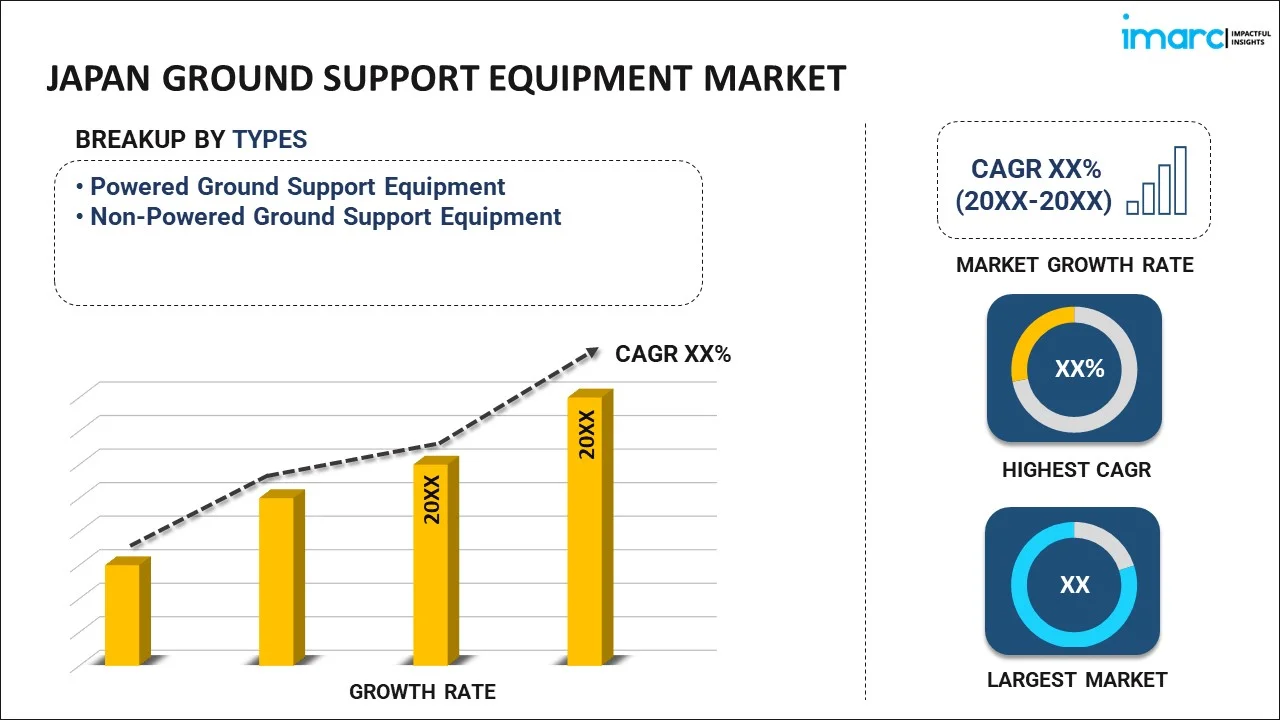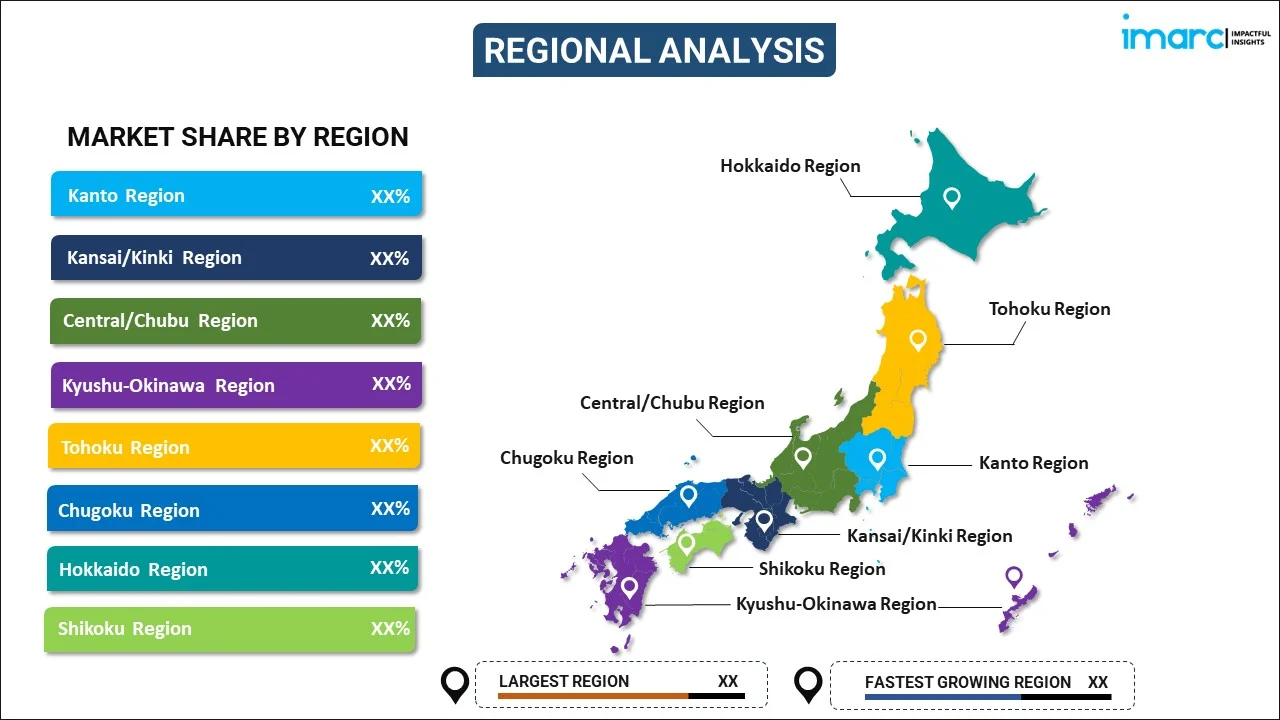
Japan Ground Support Equipment Market Report by Type (Powered Ground Support Equipment, Non-Powered Ground Support Equipment), Application (Aircraft Handling, Passenger Handling, Cargo Handling), and Region 2025-2033
Market Overview:
Japan ground support equipment market size reached USD 1.1 Billion in 2024. Looking forward, IMARC Group expects the market to reach USD 2.1 Billion by 2033, exhibiting a growth rate (CAGR) of 6.5% during 2025-2033. The market is being driven by various factors, including the increasing need for efficient aircraft servicing tools due to rising air travel demand, the integration of advanced technologies like automation and robotics into airport operations, and the rapid expansion and modernization of airport infrastructures.
|
Report Attribute
|
Key Statistics
|
|---|---|
|
Base Year
|
2024 |
|
Forecast Years
|
2025-2033
|
|
Historical Years
|
2019-2024
|
| Market Size in 2024 | USD 1.1 Billion |
| Market Forecast in 2033 | USD 2.1 Billion |
| Market Growth Rate (2025-2033) | 6.5% |
Ground support equipment (GSE) comprise specialized tools and devices used at airports to facilitate the efficient handling of aircraft during their periods on the ground. These tools are crucial for various aircraft servicing tasks, including refueling, cargo handling, passenger transport, and the maintenance of critical systems. GSE possesses the versatility to perform a wide range of functions essential for flight preparation, maintenance, and safety. It ensures on-time departures and arrivals, facilitates the smooth transfer of passengers and cargo, and ensures the proper operation of aircraft components. Whether it involves towing aircraft to and from gates, supplying electrical power, or managing waste and water services, ground support equipment play an indispensable role in the aviation sector by carrying out diverse and vital functions that enable aircraft to operate efficiently and safely.
Japan Ground Support Equipment Market Trends:
In the context of the Japanese market, several key factors are steering its growth. Foremost among these is the escalating demand for air travel, necessitating the deployment of more advanced and efficient aircraft servicing tools. Simultaneously, the ongoing advancements and increased incorporation of modern technologies like automation and robotics within airport operations are adding momentum to market expansion. Furthermore, stringent regulations pertaining to safety and environmental sustainability are emerging as significant drivers for the market. Besides this, the rapid expansion and modernization of airport infrastructure, coupled with the upsurge in air cargo transportation, are leading to increased investments in high-quality support equipment. The market is further propelled by the emergence of low-cost carriers, a growing appetite for tailored solutions to meet specific requirements, and the continual expansion of regional airports. Additionally, an increase in the number of operational aircraft and the market's embrace of innovative, eco-friendly solutions are contributing to its growth. Other notable factors, including a cultural shift toward more open dialogues concerning aviation efficiency and safety, the rising demand for cost-effective support equipment, and extensive research and development (R&D) endeavors, are projected to bolster the market growth in the coming years.
Japan Ground Support Equipment Market Segmentation:
IMARC Group provides an analysis of the key trends in each segment of the market, along with forecasts at the country level for 2025-2033. Our report has categorized the market based on type and application.
Type Insights:

- Powered Ground Support Equipment
- Non-Powered Ground Support Equipment
The report has provided a detailed breakup and analysis of the market based on the type. This includes powered ground support equipment and non-powered ground support equipment.
Application Insights:
- Aircraft Handling
- Passenger Handling
- Cargo Handling
A detailed breakup and analysis of the market based on the application have also been provided in the report. This includes aircraft handling, passenger handling, and cargo handling.
Regional Insights:

- Kanto Region
- Kansai/Kinki Region
- Central/ Chubu Region
- Kyushu-Okinawa Region
- Tohoku Region
- Chugoku Region
- Hokkaido Region
- Shikoku Region
The report has also provided a comprehensive analysis of all the major regional markets, which include Kanto Region, Kansai/Kinki Region, Central/ Chubu Region, Kyushu-Okinawa Region, Tohoku Region, Chugoku Region, Hokkaido Region, and Shikoku Region.
Competitive Landscape:
The market research report has also provided a comprehensive analysis of the competitive landscape. Competitive analysis such as market structure, key player positioning, top winning strategies, competitive dashboard, and company evaluation quadrant has been covered in the report. Also, detailed profiles of all major companies have been provided.
Japan Ground Support Equipment Market Report Coverage:
| Report Features | Details |
|---|---|
| Base Year of the Analysis | 2024 |
| Historical Period | 2019-2024 |
| Forecast Period | 2025-2033 |
| Units | Billion USD |
| Scope of the Report | Exploration of Historical Trends and Market Outlook, Industry Catalysts and Challenges, Segment-Wise Historical and Future Market Assessment:
|
| Types Covered | Powered Ground Support Equipment, Non-Powered Ground Support Equipment |
| Applications Covered | Aircraft Handling, Passenger Handling, Cargo Handling |
| Regions Covered | Kanto Region, Kansai/Kinki Region, Central/ Chubu Region, Kyushu-Okinawa Region, Tohoku Region, Chugoku Region, Hokkaido Region, Shikoku Region |
| Customization Scope | 10% Free Customization |
| Post-Sale Analyst Support | 10-12 Weeks |
| Delivery Format | PDF and Excel through Email (We can also provide the editable version of the report in PPT/Word format on special request) |
Key Questions Answered in This Report:
- How has the Japan ground support equipment market performed so far and how will it perform in the coming years?
- What has been the impact of COVID-19 on the Japan ground support equipment market?
- What is the breakup of the Japan ground support equipment market on the basis of type?
- What is the breakup of the Japan ground support equipment market on the basis of application?
- What are the various stages in the value chain of the Japan ground support equipment market?
- What are the key driving factors and challenges in the Japan ground support equipment?
- What is the structure of the Japan ground support equipment market and who are the key players?
- What is the degree of competition in the Japan ground support equipment market?
Key Benefits for Stakeholders:
- IMARC’s industry report offers a comprehensive quantitative analysis of various market segments, historical and current market trends, market forecasts, and dynamics of the Japan ground support equipment market from 2019-2033.
- The research report provides the latest information on the market drivers, challenges, and opportunities in the Japan ground support equipment market.
- Porter's five forces analysis assist stakeholders in assessing the impact of new entrants, competitive rivalry, supplier power, buyer power, and the threat of substitution. It helps stakeholders to analyze the level of competition within the Japan ground support equipment industry and its attractiveness.
- Competitive landscape allows stakeholders to understand their competitive environment and provides an insight into the current positions of key players in the market.
Need more help?
- Speak to our experienced analysts for insights on the current market scenarios.
- Include additional segments and countries to customize the report as per your requirement.
- Gain an unparalleled competitive advantage in your domain by understanding how to utilize the report and positively impacting your operations and revenue.
- For further assistance, please connect with our analysts.
 Inquire Before Buying
Inquire Before Buying
 Speak to an Analyst
Speak to an Analyst
 Request Brochure
Request Brochure
 Request Customization
Request Customization




.webp)




.webp)












